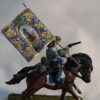Various Nefarious
Home › Forums › Historical › Black Powder › Various Nefarious
- This topic has 5 replies, 4 voices, and was last updated 3 years, 8 months ago by
 George.
George.
-
AuthorPosts
-
August 8, 2020 at 12:57 am #180493
 SteveTParticipant
SteveTParticipantOur test games of Black Powder are going well. Game seems to produce good results and is more dynamic than other rule sets.
However, play has raised a few questions, if I may…
(1) Initiative Orders. Pretty sure you don’t roll command tests. They are automatic. Correct?
(2) Hand Combat: Both sides received heavy casualties over their stamina limit. One side scored more than the other. We assumed both had to do 1 break test each for taking heavy losses. But would the loser of the fight have to do a further break test , just for being the loser of the fight?
(3) Moving and then firing. This is perhaps the most confusing. I think, under BP 2 rules, a unit can move three times and still get to fire in the shooting phase. I’ve seen something in Clash of Eagles that “suggests” if you move more than 1 you cannot fire, but I’ve seen conflicting advice on forums. So, very unclear here on what the general consensus is. This has a major effect on game outcome, and shouldn’t be a trivial decision or option!
(4) Clear targets. The book, when talking about non-clear targets, says they “can be ignored”. Does this mean you can still shoot them if you want, and take the targeting penalty?
Cheers
-
This topic was modified 3 years, 8 months ago by
 SteveT.
SteveT.
August 8, 2020 at 7:33 am #180498 Garry WillsParticipant
Garry WillsParticipant1. Yes initiative moves are automatic but they must be done before you start issuing orders. (p.32)
2. Only the losers take a break test. The winners simply ignore the excess casualties and they are removed. (p.71-2).
3. This rule of not firing if you have moved more than once was introduced in the First Argument of Kings as being particularly suitable for the early part of the period and as you say it was suggested in Clash of Eagles. Some people have changed the turn order to shoot before you move to fix the same problem of troops advancing three moves and then firing before the defenders get the opportunity to fire. It is difficult to say was is typical of games of Black Powder, but I certainly use the ‘no firing if you move more than once ‘option in my games, which is a simpler way to fix the problem. Simpler in that it has least effect on the other rules for the game. I am sure that there are lots of people who play with the standard rules quite happily, for example the Great Game in Glasgow which re-fought, in 2019, Waterloo with 22,000 figures did not use this modification. It is one of those things that seems wrong but probably has less effect on the average game than we all imagine. The rules writers clearly expected all units to charge into hand to hand combat as soon as possible, in which case closing fire comes into play.
4. Yes – it is always best to take the rules literally as written.
Glad you are enjoying the games.
All the best
Garry Wills
August 8, 2020 at 10:27 am #180500 Big AlParticipant
Big AlParticipantGarry has answered your questions correctly, except that the supplement is Last Argument of Kings, not First ;-).
The idea of not shooting after a number of moves is generally thought of as a good idea. However, it assumes that you are actually moving the full distance over turn. I never use it, as I don’t agree with it because there is no prescribed time frame for each turn. It is variable and therefore, there is nothing to say how long a unit has taken to move however far, regardless of distance. By introducing the shooting restriction, you are now assuming that units no longer have time to prepare to fire during a turn. If they move at all, they should have the same restriction.
Further, a simple formation change takes a full move. That could be just a left or about face, yet that would then prevent you shooting just because your unit turned on the spot and took a step forward. Again, this is the variable time scale being unclear! At the end of the day, you are a general in command of an army and such minutiae are of no concern to you. All you want is your orders carried out.
As to 4) Yes, the choice is yours whether you ignore an unclear target or not. The rule is that you shoot at the closest enemy. However, if the closest enemy is an obscured target, you can opt to fire at a clear and more obvious one. May, not Must!
August 8, 2020 at 10:32 am #180501 SteveTParticipant
SteveTParticipantThank you Garry and Al, very helpful.
However, for (2) both sides taking heavy losses over their stamina in hand combat: I can’t see any reference on p71-72 that says the winner just throws away any excess casualty (shaken) markers. I thought any unit that takes excess hits needs a break test regardless of where or when?
August 8, 2020 at 10:53 am #180507 Garry WillsParticipant
Garry WillsParticipantThanks for the correction Big Al.
Regarding Break tests see p.77, which lists the specific occasions when break tests are required. P.81 says you remove excess casualties after all NECESSARY break tests are done. Consequently putting the two together, winning units with excess casualties can remove them without a break test.
To Big Al’s point about moving and firing, he is obviously an example of someone who sees no problem. For me the 1 move restriction allows formation changes and turning to face. It is really up to you to choose the best way for your games. My advice is to play the game many times as they are written in the main rulebook, so that you get a good understanding of them before changing anything.
All the best
Garry
August 8, 2020 at 4:24 pm #180546 GeorgeParticipant
GeorgeParticipantGreat answers. Steve, great questions!
-
This topic was modified 3 years, 8 months ago by
-
AuthorPosts
- You must be logged in to reply to this topic.
